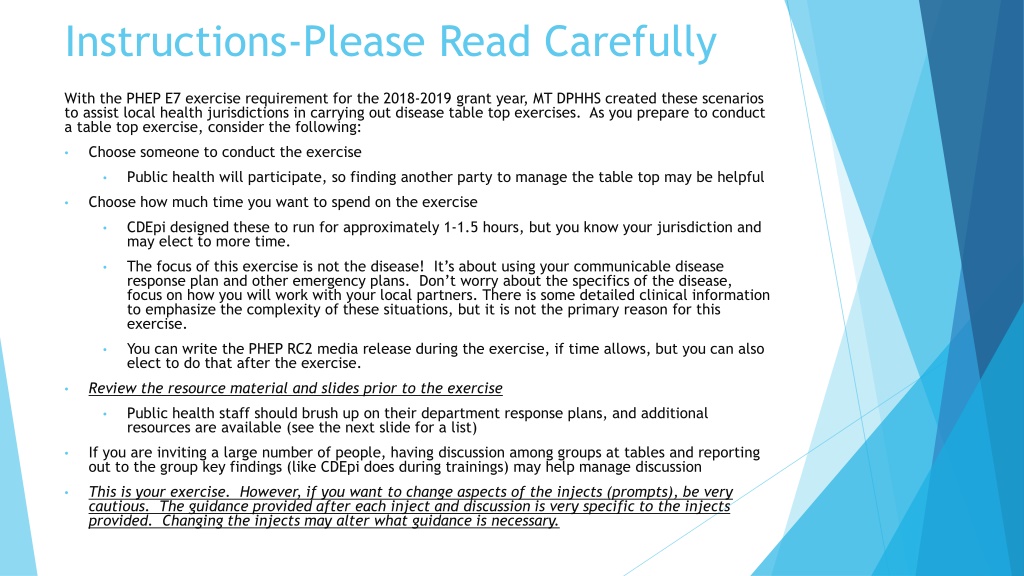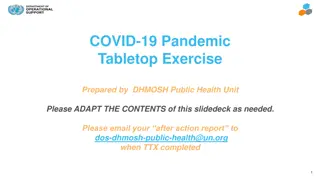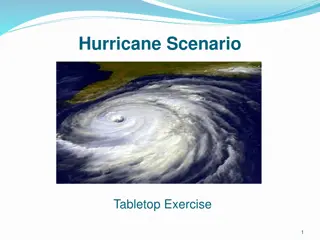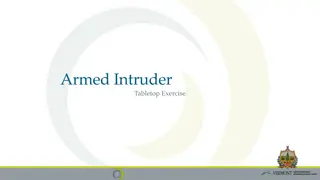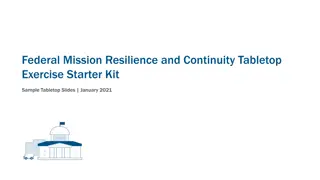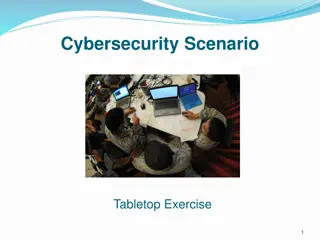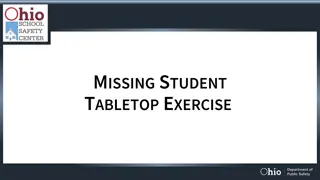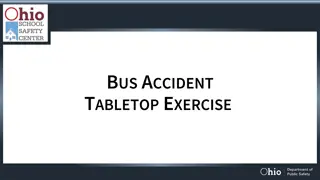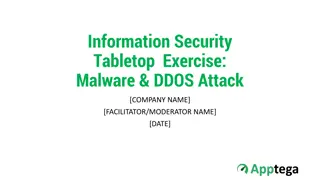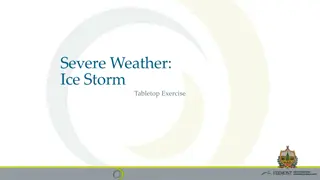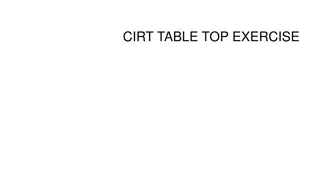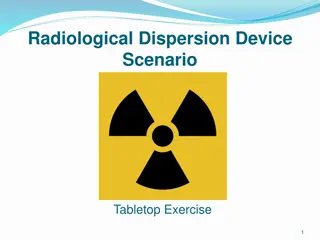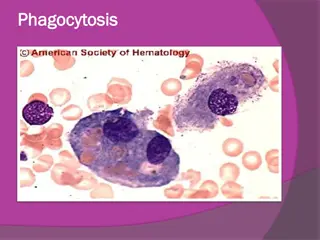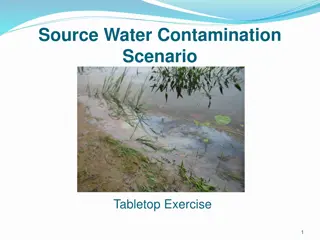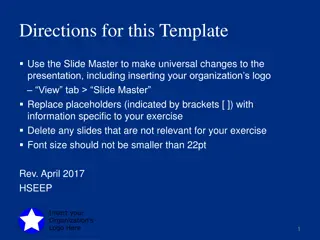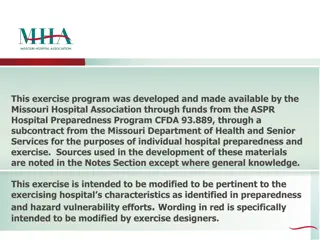Disease Tabletop Exercise: Suspected Tuberculosis Response Plan
Local health jurisdictions in Montana are preparing for disease tabletop exercises focusing on activating emergency response plans for suspected tuberculosis cases. The exercise aims to engage public health partners, clarify response roles, and identify strengths and gaps in emergency preparedness plans. Resources such as the Communicable Disease Manual and guidelines for isolation precautions in hospitals are provided to assist in the exercise.
- Disease Tabletop Exercise
- Public Health Emergency Response
- Tuberculosis Response Plan
- Emergency Preparedness
- Health Jurisdictions
Uploaded on Sep 23, 2024 | 0 Views
Download Presentation

Please find below an Image/Link to download the presentation.
The content on the website is provided AS IS for your information and personal use only. It may not be sold, licensed, or shared on other websites without obtaining consent from the author. Download presentation by click this link. If you encounter any issues during the download, it is possible that the publisher has removed the file from their server.
E N D
Presentation Transcript
Instructions-Please Read Carefully With the PHEP E7 exercise requirement for the 2018-2019 grant year, MT DPHHS created these scenarios to assist local health jurisdictions in carrying out disease table top exercises. As you prepare to conduct a table top exercise, consider the following: Choose someone to conduct the exercise Public health will participate, so finding another party to manage the table top may be helpful Choose how much time you want to spend on the exercise CDEpi designed these to run for approximately 1-1.5 hours, but you know your jurisdiction and may elect to more time. The focus of this exercise is not the disease! It s about using your communicable disease response plan and other emergency plans. Don t worry about the specifics of the disease, focus on how you will work with your local partners. There is some detailed clinical information to emphasize the complexity of these situations, but it is not the primary reason for this exercise. You can write the PHEP RC2 media release during the exercise, if time allows, but you can also elect to do that after the exercise. Review the resource material and slides prior to the exercise Public health staff should brush up on their department response plans, and additional resources are available (see the next slide for a list) If you are inviting a large number of people, having discussion among groups at tables and reporting out to the group key findings (like CDEpi does during trainings) may help manage discussion This is your exercise. However, if you want to change aspects of the injects (prompts), be very cautious. The guidance provided after each inject and discussion is very specific to the injects provided. Changing the injects may alter what guidance is necessary.
Resources-Review Montana Code Annotated Title 50-1-102 General Powers and Duties Montana Code Annotated Title 50-16-601 to 611 Government Health Care Information Act Montana Code Annotated Title 50, Chapter 2, Local Boards of Health Administrative Rules of Montana, 37. 114.1001 to 1016 Control of Communicable Disease Manual (CCDM) adopted by reference in ARM 37.114.201(2) Guidelines for Isolation Precautions in Hospitals. Adopted by reference in ARM 37.114.101(9) Official American Thoracic Society/Centers for Disease Control and Prevention/Infectious Diseases Society of America Clinical Practice Guidelines: Treatment of Drug-Susceptible Tuberculosis, published in Clinical Infectious Diseases, October 1, 2016. Adopted by reference in ARM 37.114.1006 See the Epi Resource Page for examples of messaging and other materials.
Communicable Disease Table Top Exercise Suspected Tuberculosis in a Sensitive Setting
Objectives 1. Exercise activation of the local health jurisdiction public health emergency response plans: Activation of emergency response operations a) Case confirmation b) Laboratory testing considerations with emergency specimen transport c) Mandatory exclusion of susceptible populations or enforcement of public health law d) Public health management of contacts e) Communication with public and response partners f) 2. Engage local public health partners in an exercise to clarify roles in response. 3. Identify gaps and strengths in emergency preparedness plans: Public health a) Coordinating response plans with partners (hospital preparedness, DES, etc.) b)
Why is DPHHS asking us to conduct this exercise? In 2016, local health jurisdictions were asked how prepared they were to respond to a communicable disease event: About two-thirds of jurisdictions did not feel prepared to enact non-pharmaceutical interventions (steps taken that may include isolation or quarantine) when necessary About one-third of jurisdictions did not feel fully prepared to perform communicable disease surveillance and investigation activities Gaps were identified in real-life disease events in the past two years
A few things to consider This scenario is designed to test your local response to a suspect or confirmed public health threat. Artificialities may occur depending on your jurisdiction s size and resources. The time it will take to run this exercise will vary depending on your assembled team. Format: INFORMATION bulleted in green QUESTIONS/DISCUSSION POINTS bulleted in red Stop the slides when you see red, and the answers or guidance information will be on the following slide or slides. ANSWERS bulleted in blue and italicized
Partners and Applicable Plans RECOMMENDED PARTNERS IN THIS EXERCISE: Local Health Officer Lead Local Health Official Local County Attorney (If Available) Board Of Health Members Public Health Communicable Disease Staff Infection Preventionist/Infection Control Staff From Local Hospital(s) Infectious Disease Provider (If Available) Laboratory Personnel Law Enforcement Other local partners you wish to include, such as Disaster and Emergency Services Staff APPLICABLE PUBLIC HEALTH PLANS/ANNEXES/STANDARD OPERATING PROCEDURES All-Hazards Plan Communicable Disease Response Plan Non-Pharmaceutical Interventions Plan (may be titled an Isolation and Quarantine Plan) Laboratory Sample Transport Plan Health Alert Network (HAN) Plan Risk Communication Policies and/or Crisis And Emergency Risk Communication Plan
Montana Code Annotated (MCA) 50-1-202, General Powers and Duties (MT DPHHS Powers) 50-1-204, Quarantine and Isolation Measures (MT DPHHS Powers) 50-2-115, Legal Adviser to Local Boards of Health County Attorney 50-2-116 Powers and Duties of Local Boards of Health (i) epidemiological tracking and investigation; (ii) screening and testing; (iii) isolation and quarantine measures; 50-2-118 Powers and Duties of Local Health Officers (or Authorized Representative) (4) board of health establish and maintain quarantine and isolation measures as adopted by the local 50-2-120 Assistance from Law Enforcement Officials
Administrative Rules of Montana (ARM) Pertaining to TB 37.114.1001-Tuberculosis Diagnosis 37.114.1002-Tuberculosis: Active Disease 37.114.1005-Tuberculosis: Isolation of Case Testing and Quarantine of Contacts 37.114.1006-Treatment Standards 37.114.1015-Case Follow-Up, Reporting, and Contact Investigation 37.114.1016-Submission of a Specimen or Culture
Scenario A provider at your local hospital contacts the local health department to report a suspect tuberculosis (TB) case in a hospitalized patient. The patient intends to leave the hospital against medical advice, and the provider wants to know if the patient should be held involuntarily until TB is either confirmed or ruled out. The patient works as a certified nurse s aide (CNA) in a local nursing home. What questions would you ask the provider during that call?
Gather information Ask the caller for: Demographic and contact information of the case; What supportive past and present laboratory testing they have collected for TB; History of positive tuberculin skin test (TST) or Quantiferon/T. Spot testing Acid fast bacillus (AFB) smears from sputum or other specimens Nucleic Acid Amplification Test (NAAT) for TB TB culture results What signs and symptoms were reported; If there was any known exposure to an infectious TB patient; Let the caller know public health will look into the case, but may have to call back for more information.
Initial Findings The provider states the patient is 59 years old and has been coughing for approximately 2 months with weight loss and night sweats. The patient recently started Humira three months ago for rheumatoid arthritis. The patient was hospitalized for weakness and shortness of breath. The chest x-ray has findings typical of TB. Testing for latent TB infection should have been administered prior to starting Humira, but records of the results are unavailable at this time. One sputum smear has been collected, and AFBs were present (3+) The provider placed the patient in airborne isolation, and the patient disliked it. She is leaving against medical advice. What are the reporting requirements for the provider? Is this enough information to be suspicious of TB? Suggested discussion length-5 mins
Provider Assessment The provider is reporting a suspect TB case as required by ARM. Active disease for TB is defined below: ARM 37.114.1002 TUBERCULOSIS: ACTIVE DISEASE (1) A person will be considered to have active tuberculosis until either the diagnosis of active tuberculosis is ruled out or adequate treatment is completed as determined by the local health officer or the department. (2) When a person with active tuberculosis is an in-patient at a healthcare facility, either for diagnosis, acute care, or long-term care, the facility must notify the local health officer or department before the patient is discharged from their facility.
Pubic Health Notification In this scenario, public health is involved from the beginning. In incidents involving communicable disease, notification should happen early in the process. Call public health via your local 24/7 number immediately when a reportable condition is suspected or confirmed. If you cannot reach your local public health office, you may call CDEpi at our 24/7 number (406-444-0273). Public health can provide: Guidance on confirmatory testing Public health case management and control measures Guidance on public messaging Management of contacts CDC consults, when requested Depending on the situation, other resources are available too.
Assessment, Continued ARM 37.114.1001 TUBERCULOSIS DIAGNOSIS (1) A case of active tuberculosis disease exists if the case meets the laboratory or clinical criteria in (2) or (3). (2) Laboratory criteria for active tuberculosis diagnosis: (a) isolation of M. tuberculosis complex from a clinical specimen; (b) demonstration of M. tuberculosis complex from a clinical specimen by nucleic acid amplification test; or (c) demonstration of acid-fast bacilli in a clinical specimen when a culture has not been or cannot be obtained or is falsely negative or contaminated. (3) Clinical criteria for active tuberculosis diagnosis: (a) usually a positive tuberculin skin test result or positive interferon gamma release assay for M. tuberculosis; (b) other signs and symptoms compatible with tuberculosis are for example: abnormal chest radiograph, abnormal chest computerized tomography scan or other chest imaging study, or clinical evidence of current disease; (c) treatment with two or more antituberculosis medications; and (d) a completed diagnostic evaluation. There is enough evidence present to call this a case of active TB disease until it is ruled out. The patient is leaving the facility against medical advice. What are the next actions for the provider/facility and public health? Suggested discussion length-5 mins
Why is the Patient Leaving? What has the facility has done so far with the patient regarding voluntarily remaining in the hospital? Identify the patient s reasons for refusing to stay in the hospital Determine if there is any way to overcome those barriers Identify compliance issues with these barriers. For example, is the motivation for leaving financial, or is the motivation for leaving because they distrust medical professionals? Find out if there is anyone living at home with the patient. If the patient refuses to stay in the hospital, home isolation is still an option. Identify if there people at risk for TB disease in the home.
Isolation of a Suspect TB Case When asked, the patient states: She cannot afford a hospitalization because of the high deductible of her medical insurance. Charges for isolation will increase her bills to a degree that may cause her to declare bankruptcy She understands she is very ill, and will take oral medication at home, but does not believe isolation is necessary She needs to return to work in order to pay her bills Paying for medication may be a barrier to completion of therapy What resources does your jurisdiction have available to this patient? Are there patient assistance programs with the hospital? Should public health write a mandatory isolation order at this time? Suggested discussion length-2-3 mins
Isolation of Infectious TB Patients: An isolation order from the local health officer (or designee) is recommended in this scenario Establishes a paper trail in case of problems with compliance later Shared decision making on isolation with the MT DPPHS TB Control Program is required by ARM 37.114.1005 ARM 37.114.308 outlines what must be in an isolation order Review with your legal advisor (county or tribal attorney) is strongly recommended Isolation protects others from exposure, but you also have to think about: Where the isolation will be done How long to isolate the patient When to lift the isolation order
Isolation of Infectious TB Patients: Guidelines for isolation at home following hospital discharge: A specific plan exists for follow-up care with the local tuberculosis (TB) control program. AND The patient has been started on a standard multidrug anti-tuberculosis treatment regimen and directly observed therapy (DOT) has been arranged. AND No children aged <5 years or persons with immunocompromising conditions are present in the household. AND All immunocompetent household members have been previously exposed to the patient. AND The patient is willing to remain inside the home except for healthcare- associated visits until the patient has negative acid-fast bacilli (AFB) sputum smear results.
When can the patient return to work and other social settings? The patient is on adequate therapy. AND The patient has had a significant clinical response to therapy. AND The patient has had 3 consecutive negative acid-fast bacilli (AFB) sputum smear results collected 8 to 24 hours apart, with at least 1 being an early morning specimen.
Resources Available to Support this Patient Health Department Programs What is available in your local health department, i.e., visiting nurses, etc. Nutritional support Meals on Wheels, if she qualifies Other programs like SNAP, if she qualifies TB Medication Assistance Program-DPHHS Medications to treat TB are provided by DPHHS for those who are uninsured or underinsured. Treatment standards and directly observed therapy (DOT) is required for active drug-susceptible TB disease by ARM 37.114.1006 The provider must follow the regimens outlined by: Treatment of Drug- Susceptible Tuberculosis, Clinical Infectious Diseases, October 1, 2016 The local health department may perform DOT for weekdays, and the patient can take medication themselves on the weekends May use video DOT if your local health jurisdiction has the capability
Current Status of this Scenario Your jurisdiction issued a home isolation order until criteria for release of isolation are met The patient agreed to home isolation after counseling and education regarding the disease The provider wants to start the patient on RIPE (rifampin, isoniazid, pyrazinamide, and ethambutol) therapy, and the health department wants to make DOT plans with the provider, but the provider wants to make certain this is TB first One sputum sample has been collected for this patient, but the case is not confirmed.
Laboratory Testing In this scenario, further testing is needed to confirm this is a case of active TB disease: What kind of samples do you need?
Laboratory testing Two more sputum samples should be collected The recommended number of samples are three sputum samples collected 8-24 hours apart with one being an early morning specimen Laboratory testing can be performed on these samples to gauge infectiousness of the patient, and will identify TB in the sample In this scenario, assume that the Montana Public Health Laboratory is the only lab who provides the testing you require.
Laboratory Testing The courier system for MTPHL is down and it is not clear when the service will be back up again. According to your local laboratory sample transport plan, what do you do?
Laboratory Sample Transport Plan All local health jurisdictions are required to maintain a plan specific to their resources in order to send samples to MTPHL on an emergent basis: Laboratory Sample Transport Plan (LSTP) Work with CDEpi by dialing 406-444-0273, and we will help coordinate sample testing and arrival at MTPHL during a case investigation Advice on packaging, forms, sample handling are also available from MTPHL
Also remember when cultures are positive for TB, they must be sent to MTPHL for further analysis: ARM 37.114.1016 SUBMISSION OF A SPECIMEN OR CULTURE (1) Whenever a physician diagnoses a case of tuberculosis, they must ensure that a specimen or culture from the tuberculosis case is sent to the department's public health laboratory for confirmation of the results, drug susceptibility testing, and genotyping. (2) Whenever a laboratory finds a specimen or culture is positive for M. tuberculosis, the laboratory must submit the specimen or culture to the department's public health laboratory for confirmation of the results, drug susceptibility testing, and genotyping. In this scenario, we don t have a culture positive yet. This is for your information.
Testing Results The appropriate specimen is sent to MTPHL via your laboratory sample transport plan. Testing at MTPHL shows that your patient has TB, and the patient is considered very infectious. What are your next steps? Suggested discussion length-5 mins
Assess what you have now Maintain isolation until criteria for release are met (monitoring the patient for compliance) Activate EPI Team Contact investigation Messaging Partners Public Reporting to MT DPHHS
Activate EPI Team According to your local disease response plans, who is on your epi team? This will be specific to your jurisdiction, so refer to your health department emergency operations plans for guidance.
Messaging Think about the messaging that needs to be performed between public health, the hospital, the care facility, and the local healthcare partners: Local partners-what information do you need from public health? Public health-what do your communicable disease response, risk communications, and Health Alert Network (HAN) plans say you should do?
Messaging to Public Health Partners and Affected Facilities A HAN message is recommended to surrounding healthcare partners Those who feel they have been exposed when word circulates about a TB case may appear at providers offices for testing Information regarding TB can be distributed quickly to healthcare providers The affected healthcare facilities will require messaging, as well: Staff at the hospital and at the care facility may have a questions and concerns regarding their potential exposures Perceived risk from exposure to the patient may not be actual risk (worried-well) Identify a route to manage the reports as they come in
Contact Investigation Who is considered a contact and how far back do you retrace the patient s locations she visited? How will your local health department and their local communicable disease partners manage a contact investigation together?
Contact Investigation You have time to sort through contacts and to determine who to test! Infectious period: For this patient, we would go back three months prior to symptom onset (five months back from this point in time). Determine where patient was during the infectious period through interviews and supporting documentation (i.e., timesheets) Consider the setting of where the patient was located (areas with more ventilation or out of doors are low risk as opposed to areas that are enclosed with little ventilation)
Contact Investigation Start a contact investigation with household contacts Other contacts Social and healthcare worker contacts with significant exposure Identify exposures that may have occurred at the healthcare facility where she worked and where she was diagnosed Household Contacts Most likely to be infected
Contact Investigation Prioritize contacts based on status of the source patient and the likelihood of disease in the contact Identify contacts who have symptoms consistent with TB and send them for evaluation
Contact Investigation Collect the following information on each contact: Previous tuberculosis infection (latent TB) or disease (active disease) and related treatment; Contact's verbal report and documentation of previous tuberculosis testing results (if done); Current symptoms of TB illness (e.g., cough, chest pain, fever, chills, night sweats, appetite loss, weight loss, malaise, or easily becomes tired; Medical history Type, duration, and intensity of TB exposure; and Sociodemographic factors (e.g., age, race or ethnicity, residence, and country of birth)
Hospital and Care Facility where the patient was: Infection control offices can assist and provide line lists of those they test May have other staff members who perform this function Options to Perform Large Numbers of Screenings Can train other qualified staff members to administer TSTs or blood tests when the number of those requiring screening are large Screening household contacts and the public Consider using your local health jurisdiction s Emergency Medical Counter Measures (EMC) plan, and set up a temporary clinic May be able to use your facility during normal clinic times with extra staff
New Information Contact investigations initially determine there are 90 individuals at risk for TB infection after contact with the patient 50 are residents at the care facility where she worked 10 are coworkers who worked several shifts with her during a day shifts 20 staff members were identified at the healthcare facility where she was diagnosed 5 patients were identified who were exposed while in the ER with our infectious patient (placed in isolation after being in the ER) 5 household contacts were identified Visitors to the care facility where she worked are not known, nor are the visitors to the healthcare facility where she was diagnosed. How will you identify the visitors to the two facilities who may be at risk? How will you screen the known contacts? Who are your partners (i.e., who has a vested interest in the outcome and how can the be brought in to assist)?
Identifying Visitors to the Healthcare Facilities Check to see if visitors logs exist and who was there during that days the patient worked or was hospitalized If there are no logs available, public messaging can help identify visitors Social media Press release Be specific to the days in question
Recommended Testing Contacts without a history of TB infection or TB disease should have a baseline TST or blood test performed Contacts who have been previously diagnosed with TB disease or latent infection require further assessment Rescreen these contacts at 8-10 weeks after the last exposure to the infectious patient Work with MT DPHHS and the local health department to manage these contacts If any of them are positive at baseline or at the rescreening, send them for a follow up chest x- ray to rule out active disease
TB Contacts and Disease vs. Latent TB Infection TB Disease Latent TB Infection Has no signs or symptoms of tuberculosis Has signs/symptoms of tuberculosis Test positive for TB infection with a skin tuberculin test (TST) or blood test (IGRA) They are considered infectious if TB is found in the lungs or airways Contacts who have signs and symptoms consistent with TB disease should be isolated and medically evaluated Do not quarantine TB contacts who have no signs or symptoms of disease Contacts who test positive for latent TB infection and have a normal chest x-ray should be offered treatment for latent TB infection
Public Messaging Should information be shared? If so, what information. How will public recipients receive the message? How will you collaborate between public health and the local partners for consistent messaging?
Messaging: What? With TB, you may not feel it necessary to perform a press release. However, some situations will warrant a public release of some sort, particularly in cases where misinformation is circulating or there is a great deal of concern in the community. Assume in this situation you want to create a press release. Without identifying the patient: General information about the disease and its transmission Signs/symptoms of the disease Guidance to visit healthcare provider if concerned Contact information for additional questions
Messaging: How? Public releases Press release (work with PIO) Social media (work with PIO) Message to family/household contacts The local health jurisdiction risk communication plan should address routes of public information releases
Control Measures After messaging the public, a total of 150 contacts were identified: No contacts had signs or symptoms consistent with TB disease Household contacts-2 tested positive for latent TB infections and treatment was recommended Hospital contacts-No visitors tested positive for TB infection. The respiratory therapist who cared for the patient in the ER was diagnosed with latent TB infection. He had a negative screening at baseline, but was positive at the 8 week screening. Treatment was recommended. No other staff members tested positive for latent TB infection Care facility contacts-3 of the residents at the care facility had known latent TB infections prior to the investigation. No new conversions were observed with the residents or visitors. 2 staff members that frequently worked together with the patient did test positive for latent TB infection, and treatment was recommended. 13 contacts were lost to follow up What are your final actions to wrap up this event?
Reporting Report any out of jurisdiction contacts to DPHHS will forward to appropriate jurisdiction for follow up Complete the TB Case Investigation form and submit it to MT DPHHS While the patient is being treated, local public health monitors DOT and submits a monthly status update report to MT DPHHS Send a line list of contacts and the testing outcomes to MT DPHHS after contact testing is completed Perform an after action review with your response partners to look for opportunities for improvement and to identify portions of the response that went well Adjust your emergency response plans based on lessons learned
Summarize results After action report What worked Lessons learned Adjust plan as needed Review plan each year
Tabletop Completion Public health staff, please complete the worksheets provided for the tabletop, and submit them on the PHEP 3rd quarter progress report. This will meet your L1 and E7 exercise deliverables (remember to still perform your CD Response Plan Review checklist, as well, for E7). Did you identify changes needed in any of your response plan? If so, update your plans, and if you need guidance, contact your MT DPHHS PHEP staff or CDEpi staff. To complete your Risk Communications RC 2 deliverable, write a media release related to the chosen scenario using your communications plan, and assess the public information component in this AAR. Upload the media release to your progress report.
